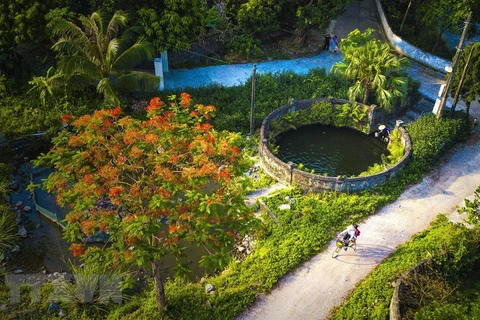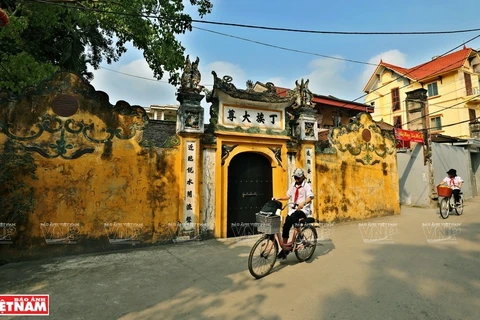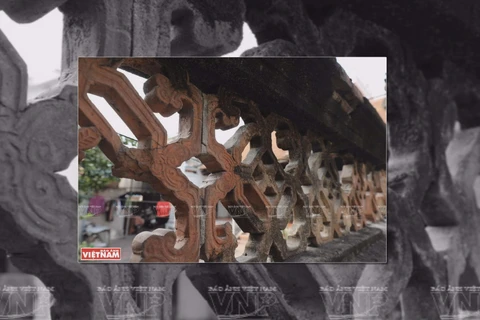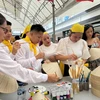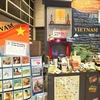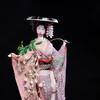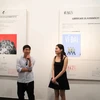 The 500-year-old Cuu village is located in Van Tu commune in Hanoi’s outskirts district of Phu Xuyen, about 40 km from the city centre. Cuu village is a unique place of Hanoi, where visitors can find traditional values and find themselves become immersed in nostalgic feelings. The village boasts ancient villas in mixed Vietnamese and French architecture style in the early twentieth century, which is the reason why it was once dubbed as “Hanoi’s western village.” With its peaceful atmosphere and unique architecture, as compared with other villages in northern Vietnam, Cuu village would be an interesting destination for tourists to travel back in time. (Photo: VietnamPlus)
The 500-year-old Cuu village is located in Van Tu commune in Hanoi’s outskirts district of Phu Xuyen, about 40 km from the city centre. Cuu village is a unique place of Hanoi, where visitors can find traditional values and find themselves become immersed in nostalgic feelings. The village boasts ancient villas in mixed Vietnamese and French architecture style in the early twentieth century, which is the reason why it was once dubbed as “Hanoi’s western village.” With its peaceful atmosphere and unique architecture, as compared with other villages in northern Vietnam, Cuu village would be an interesting destination for tourists to travel back in time. (Photo: VietnamPlus)  There are villas that combine Vietnamese – French – Chinese classical architecture in Cuu village. Many people still live in those old houses. However, there are a few abandoned French villas. Cuu village's houses still retain the ancient and luxurious features hidden behind the yin and yang tile roofs, combined with carvings and intricate arches. The village was famous for needlework and embroidery skills, and known as the Number One Tailor Village in Hanoi. Hundreds of western visitors came here for made-to-order suits. Through ups and downs, Cuu village, once dubbed as 'Hanoi's western village', still holds architectural values as a symbol of prosperity. (Photo: VietnamPlus)
There are villas that combine Vietnamese – French – Chinese classical architecture in Cuu village. Many people still live in those old houses. However, there are a few abandoned French villas. Cuu village's houses still retain the ancient and luxurious features hidden behind the yin and yang tile roofs, combined with carvings and intricate arches. The village was famous for needlework and embroidery skills, and known as the Number One Tailor Village in Hanoi. Hundreds of western visitors came here for made-to-order suits. Through ups and downs, Cuu village, once dubbed as 'Hanoi's western village', still holds architectural values as a symbol of prosperity. (Photo: VietnamPlus)  The most ancient house in Cuu villlage was built in 1929 with decorative patterns using mixed Asia-Europe architectural style. Cuu village's houses still retain the ancient and luxurious features hidden behind the yin and yang tile roofs, combined with carvings and intricate arches. The most magnificent and beautiful houses with the appearance of French villas sprang up from 1920-1945. Nestled close to the gentle Nhue River, the 500-year-old Cuu village owns the unique treasure of the capital city. Cuu village is also a favourite place for photographers and those with great passion for art, owing to the land’s unique scenery. It is also a source of inspiration for many painters. (Photo: Vietnamplus)
The most ancient house in Cuu villlage was built in 1929 with decorative patterns using mixed Asia-Europe architectural style. Cuu village's houses still retain the ancient and luxurious features hidden behind the yin and yang tile roofs, combined with carvings and intricate arches. The most magnificent and beautiful houses with the appearance of French villas sprang up from 1920-1945. Nestled close to the gentle Nhue River, the 500-year-old Cuu village owns the unique treasure of the capital city. Cuu village is also a favourite place for photographers and those with great passion for art, owing to the land’s unique scenery. It is also a source of inspiration for many painters. (Photo: Vietnamplus)  Cuu village has a quiet beauty in the afternoon. Going downstream the Nhue River to the south, anyone who enters the ancient village will encounter a completely different scene from other rural villages in northern Vietnam. Although it is still a Vietnamese village landscape with banyan trees, wells and communal yards, the architecture of the houses here has the blend of Asian and Eastern cultures. This unique characteristic made Cuu village stand out from other ancient villages in Hanoi such as Duong Lam, Uoc Le and Cu Da. The architecture of Cuu village’s houses features more than aesthetic purposes, highlighting the cultural spirit of the village. (Photo: VietnamPlus)
Cuu village has a quiet beauty in the afternoon. Going downstream the Nhue River to the south, anyone who enters the ancient village will encounter a completely different scene from other rural villages in northern Vietnam. Although it is still a Vietnamese village landscape with banyan trees, wells and communal yards, the architecture of the houses here has the blend of Asian and Eastern cultures. This unique characteristic made Cuu village stand out from other ancient villages in Hanoi such as Duong Lam, Uoc Le and Cu Da. The architecture of Cuu village’s houses features more than aesthetic purposes, highlighting the cultural spirit of the village. (Photo: VietnamPlus)  A house in Cuu village which over the years still retains the ancient features. Many people call Cuu village the "western village" because the architectural style of houses there is perhaps different from those traditional houses usually found in other old villages in northern Vietnam. During the 1920 – 1945 period, dozens of villas were built in the village with arched architecture, flowing roof and ironwood. Small details of local houses are often decorated with flowers, cranes and phoenix. The architecture still retains the ancient and luxurious features hidden behind the yin-yang, red tile roofs combined with delicate carvings and arches. Old local people in the village nowadays mostly engage in farming. (Photo: VietnamPlus)
A house in Cuu village which over the years still retains the ancient features. Many people call Cuu village the "western village" because the architectural style of houses there is perhaps different from those traditional houses usually found in other old villages in northern Vietnam. During the 1920 – 1945 period, dozens of villas were built in the village with arched architecture, flowing roof and ironwood. Small details of local houses are often decorated with flowers, cranes and phoenix. The architecture still retains the ancient and luxurious features hidden behind the yin-yang, red tile roofs combined with delicate carvings and arches. Old local people in the village nowadays mostly engage in farming. (Photo: VietnamPlus)  Only about 40 kilometers from Hanoi’s centre, Cuu village still preserves many enchanting historical and cultural features, offering a tranquil and nostalgic weekend getaway. The village boasts many ancient houses in mixed Vietnamese and French architecture style in the early twentieth century. It was once dubbed as “Hanoi’s western village” for this reason. During the 1920 – 1945 period, dozens of villas were built in the village with arched architecture, flowing roof and ironwood. Small details of local houses are often decorated with flowers, cranes and phoenix. Many people still live in those ancient houses. However, there are also a few abandoned French villas. (Photo: VietnamPlus)
Only about 40 kilometers from Hanoi’s centre, Cuu village still preserves many enchanting historical and cultural features, offering a tranquil and nostalgic weekend getaway. The village boasts many ancient houses in mixed Vietnamese and French architecture style in the early twentieth century. It was once dubbed as “Hanoi’s western village” for this reason. During the 1920 – 1945 period, dozens of villas were built in the village with arched architecture, flowing roof and ironwood. Small details of local houses are often decorated with flowers, cranes and phoenix. Many people still live in those ancient houses. However, there are also a few abandoned French villas. (Photo: VietnamPlus)  A clean village road runs between old houses in Cuu village. Entering spacious, clean alleys along the road, you will be immersed in a quiet, peaceful atmosphere. While other ancient villages in Northern Vietnam such as Duong Lam and Cu Da have become popular tourist destinations, Cuu village still strangely stays outside the travel trade spiral. Located in Van Tu commune, Phu Xuyen district, about 40 kilometres from the centre of Hanoi, Cuu village preserves ancient values of the capital city. With its peaceful atmosphere and unique architecture, Cuu village would be an interesting destination for tourists to travel back in time. (Photo: VietnamPlus)
A clean village road runs between old houses in Cuu village. Entering spacious, clean alleys along the road, you will be immersed in a quiet, peaceful atmosphere. While other ancient villages in Northern Vietnam such as Duong Lam and Cu Da have become popular tourist destinations, Cuu village still strangely stays outside the travel trade spiral. Located in Van Tu commune, Phu Xuyen district, about 40 kilometres from the centre of Hanoi, Cuu village preserves ancient values of the capital city. With its peaceful atmosphere and unique architecture, Cuu village would be an interesting destination for tourists to travel back in time. (Photo: VietnamPlus)  A moss-covered gate of an old house in Cuu village. The village cultural space and architecture that have taken shape and crystallized themselves after hundreds of years come as a profound manifestation of the Vietnamese wet-rice civilization. This modest old village is located on the banks of the Nhue River, witnessing various changes in geography and time. The story goes that the village land used to be just a pile of dykes on the banks of the Nhue River, after which the displaced people came and gradually settled down, building their home there. That time dates back at least 500 years ago, according to the village’s old guard. (Photo: VNA)
A moss-covered gate of an old house in Cuu village. The village cultural space and architecture that have taken shape and crystallized themselves after hundreds of years come as a profound manifestation of the Vietnamese wet-rice civilization. This modest old village is located on the banks of the Nhue River, witnessing various changes in geography and time. The story goes that the village land used to be just a pile of dykes on the banks of the Nhue River, after which the displaced people came and gradually settled down, building their home there. That time dates back at least 500 years ago, according to the village’s old guard. (Photo: VNA)  The special thing about the old houses in the village is the mix of ancient Vietnamese architecture (curved roof tiles, pillars) and French architecture (arch design). The influence of Western architecture is not difficult to understand, when the country was under the French colonial rule for many years. Some of the most beautiful houses in Hanoi’s Old Quarter also inherited this style. The process of building these works took place in the years from 1920 to 1945. Nowadays, the village still keeps architectural heritage houses lying in between modern houses. Over time, some moss-covered houses are gradually degrading due to a lack of care and restoration. Only a few houses having undergone conservation work remain intact. (Photo: VNA)
The special thing about the old houses in the village is the mix of ancient Vietnamese architecture (curved roof tiles, pillars) and French architecture (arch design). The influence of Western architecture is not difficult to understand, when the country was under the French colonial rule for many years. Some of the most beautiful houses in Hanoi’s Old Quarter also inherited this style. The process of building these works took place in the years from 1920 to 1945. Nowadays, the village still keeps architectural heritage houses lying in between modern houses. Over time, some moss-covered houses are gradually degrading due to a lack of care and restoration. Only a few houses having undergone conservation work remain intact. (Photo: VNA)  Remaining spacious villas show what the village looked like during prosperous times. In the past, local rice fields were usually submerged during flood season, so farmers could only grow one crop a year, and the life of villagers was very difficult. In 1921 a fire destroyed half the village. Many farmers left the village to go to different parts of the country to earn their living. Some of them became wealthy tailors. With skilled hands, they made fashionable suits and dresses for the French and wealthy people in Hanoi. Soon tailors from Cuu village earned reputation for their craft of making clothes for western people. Many of them did a good business and became rich. (Photo: VietnamPlus)
Remaining spacious villas show what the village looked like during prosperous times. In the past, local rice fields were usually submerged during flood season, so farmers could only grow one crop a year, and the life of villagers was very difficult. In 1921 a fire destroyed half the village. Many farmers left the village to go to different parts of the country to earn their living. Some of them became wealthy tailors. With skilled hands, they made fashionable suits and dresses for the French and wealthy people in Hanoi. Soon tailors from Cuu village earned reputation for their craft of making clothes for western people. Many of them did a good business and became rich. (Photo: VietnamPlus)  At that time French architecture was popular in large cities, such as Hanoi and Hai Phong. The villagers incorporated this style into their own dwellings. Many of their houses had the appearance of French villas. All the villas were usually decorated with lacquered boards engraved with Chinese scripts and couplets. Above the door, there was an embossed letter with a sword and a pen brush on both sides. It is interesting that the architectural style and the ways of decorating the villas show the specific characteristics of each family or clan. For some villas, it took craftsmen up to one year to carve the doors. (Photo: VietnamPlus)
At that time French architecture was popular in large cities, such as Hanoi and Hai Phong. The villagers incorporated this style into their own dwellings. Many of their houses had the appearance of French villas. All the villas were usually decorated with lacquered boards engraved with Chinese scripts and couplets. Above the door, there was an embossed letter with a sword and a pen brush on both sides. It is interesting that the architectural style and the ways of decorating the villas show the specific characteristics of each family or clan. For some villas, it took craftsmen up to one year to carve the doors. (Photo: VietnamPlus)  Visitors to Cuu Village enjoy walking along the lanes and visiting the old villas which are reminiscent of the peaceful atmosphere of an affluent village in the past. Today, the old villas and lanes paved with green stone blocks in Cuu Village still remain. Although these villas are covered in moss, they still retain their beauty. Visiting this village, people can imagine the flourishing period of the village, as shown in the delicate features of the old villas. The special thing of the houses in the village is in the mix of ancient Vietnamese architecture (curved roof tiles, pillars) and French style (arch design). (Photo: VietnamPlus)
Visitors to Cuu Village enjoy walking along the lanes and visiting the old villas which are reminiscent of the peaceful atmosphere of an affluent village in the past. Today, the old villas and lanes paved with green stone blocks in Cuu Village still remain. Although these villas are covered in moss, they still retain their beauty. Visiting this village, people can imagine the flourishing period of the village, as shown in the delicate features of the old villas. The special thing of the houses in the village is in the mix of ancient Vietnamese architecture (curved roof tiles, pillars) and French style (arch design). (Photo: VietnamPlus)  The influence of Western architecture in Cuu village is not difficult to understand, as the country was under the colonial rule of the French for a long time. Many of the most beautiful houses in Hanoi’s Old Quarter also inherited this style. The process of building those works took place in the years from 1920 to 1945. Visitors to Cuu Village enjoy walking along the lanes paved with bricks and visiting the old villas which are reminiscent of the peaceful atmosphere of an affluent village in the past. In addition to visiting the village, they can stroll around the banks of the Nhue River nearby. The dyke banks have beautiful grass, where you can have a small picnic there. (Photo: VietnamPlus)
The influence of Western architecture in Cuu village is not difficult to understand, as the country was under the colonial rule of the French for a long time. Many of the most beautiful houses in Hanoi’s Old Quarter also inherited this style. The process of building those works took place in the years from 1920 to 1945. Visitors to Cuu Village enjoy walking along the lanes paved with bricks and visiting the old villas which are reminiscent of the peaceful atmosphere of an affluent village in the past. In addition to visiting the village, they can stroll around the banks of the Nhue River nearby. The dyke banks have beautiful grass, where you can have a small picnic there. (Photo: VietnamPlus)  The peaceful old Cuu village, located on the banks of the Nhue River, has witnessed numerous changes in geography and time. The story goes that the village used to be just a pile of dykes on the banks of the Nhue River. But then displaced people from other places came and gradually settled down. That time dates back at least 500 years ago, according to the village’s old guard. As French architecture was popular in the large cities such as Hanoi and Hai Phong, the villagers incorporated this style into their own dwellings. Many of their houses had the appearance of French villas. (Photo: VietnamPlus)
The peaceful old Cuu village, located on the banks of the Nhue River, has witnessed numerous changes in geography and time. The story goes that the village used to be just a pile of dykes on the banks of the Nhue River. But then displaced people from other places came and gradually settled down. That time dates back at least 500 years ago, according to the village’s old guard. As French architecture was popular in the large cities such as Hanoi and Hai Phong, the villagers incorporated this style into their own dwellings. Many of their houses had the appearance of French villas. (Photo: VietnamPlus)  A project was launched in February, 2020, aiming to promote handicrafts and tourism in Cuu village. The village had been known for many years as a tailoring hub. Thanks to the industry, residents had become rich. Their prosperity could be seen in the architecture of houses built in the first decades of the 20th century. Currently, Cuu village has about 37 villas. The village is still peaceful and quiet at a time when internet cafés and karaoke parlors can be found in most villages in the country. The village has great potential for tourism growth because there are no signs of commercialisation. It has become the destination for many people passionate with art like photographers or architecture students. (Photo: VietnamPlus)
A project was launched in February, 2020, aiming to promote handicrafts and tourism in Cuu village. The village had been known for many years as a tailoring hub. Thanks to the industry, residents had become rich. Their prosperity could be seen in the architecture of houses built in the first decades of the 20th century. Currently, Cuu village has about 37 villas. The village is still peaceful and quiet at a time when internet cafés and karaoke parlors can be found in most villages in the country. The village has great potential for tourism growth because there are no signs of commercialisation. It has become the destination for many people passionate with art like photographers or architecture students. (Photo: VietnamPlus)  The conservation project hopes to turn Cuu village into a creative centre, contributing to the city’s development. Old people said in 1921 a fire destroyed half the village. Many farmers left the village to go to different parts of the country to earn their living. Some of them became wealthy tailors. Phuc My and his brother, Phuc Hung were the first Cuu villagers to become tailors and were known as the top tailors in Hanoi. With skilled hands they made fashionable suits and dresses for the French and wealthy people in Hanoi. Soon many Cuu villagers earned fame for their work in making western-style clothes. (Photo: VNA)
The conservation project hopes to turn Cuu village into a creative centre, contributing to the city’s development. Old people said in 1921 a fire destroyed half the village. Many farmers left the village to go to different parts of the country to earn their living. Some of them became wealthy tailors. Phuc My and his brother, Phuc Hung were the first Cuu villagers to become tailors and were known as the top tailors in Hanoi. With skilled hands they made fashionable suits and dresses for the French and wealthy people in Hanoi. Soon many Cuu villagers earned fame for their work in making western-style clothes. (Photo: VNA)  The remaining spacious villas show what the village looked like during prosperous times. The golden age of the Cuu village was a long time ago, but somewhere we can still feel the bustling atmosphere of the “Tailor Village of Hanoi”. It is interesting that the architectural style and the ways of decorating the villas show the specific characteristics of each family or clan. According to the village elders, in the past, wealthy people in the village were very finicky about building their houses. For some villas, it took craftsmen a year to carve the doors. Visiting this village, people can imagine the flourishing period of the village, as shown in the delicate features of the old villas. (Photo: VietnamPlus)
The remaining spacious villas show what the village looked like during prosperous times. The golden age of the Cuu village was a long time ago, but somewhere we can still feel the bustling atmosphere of the “Tailor Village of Hanoi”. It is interesting that the architectural style and the ways of decorating the villas show the specific characteristics of each family or clan. According to the village elders, in the past, wealthy people in the village were very finicky about building their houses. For some villas, it took craftsmen a year to carve the doors. Visiting this village, people can imagine the flourishing period of the village, as shown in the delicate features of the old villas. (Photo: VietnamPlus)  Over time, many moss-covered old houses are gradually degrading due to a lack of care and restoration. Only a few houses that have undergone conservation work remain intact. The special thing of the houses in the village is the mix of ancient Vietnamese architecture (curved roof tiles, pillars) and French style (arch design). The influence of Western architecture is not difficult to understand, as the country was under colonial rule of the French for a long time. Many of the most beautiful houses in Hanoi’s Old Quarter also inherited this style. The process of building these works took place in the years from 1920 to 1945. In the 2000s, many old villas in the former village of Hanoi were rebuilt due to deterioration. (Photo: VietnamPlus)
Over time, many moss-covered old houses are gradually degrading due to a lack of care and restoration. Only a few houses that have undergone conservation work remain intact. The special thing of the houses in the village is the mix of ancient Vietnamese architecture (curved roof tiles, pillars) and French style (arch design). The influence of Western architecture is not difficult to understand, as the country was under colonial rule of the French for a long time. Many of the most beautiful houses in Hanoi’s Old Quarter also inherited this style. The process of building these works took place in the years from 1920 to 1945. In the 2000s, many old villas in the former village of Hanoi were rebuilt due to deterioration. (Photo: VietnamPlus)  The 500-year-old Cuu village is located in Van Tu commune in Hanoi’s outskirts district of Phu Xuyen, about 40 km from the city centre. Van Tu commune is known as the only place in Vietnam to have suit making as a traditional craft. There are about 1,500 households in the commune at present. The capital city boasts 1,350 craft villages, which account for almost one-third of the total number across Vietnam, with 305 of them recognised as traditional ones. In Phu Xuyen district, the fact that many long-standing craft villages have not been officially recognised has somehow made it hard for them to become more popular among tourists. As a result, their potential has yet to be fully tapped. (Photo: VietnamPlus)
The 500-year-old Cuu village is located in Van Tu commune in Hanoi’s outskirts district of Phu Xuyen, about 40 km from the city centre. Van Tu commune is known as the only place in Vietnam to have suit making as a traditional craft. There are about 1,500 households in the commune at present. The capital city boasts 1,350 craft villages, which account for almost one-third of the total number across Vietnam, with 305 of them recognised as traditional ones. In Phu Xuyen district, the fact that many long-standing craft villages have not been officially recognised has somehow made it hard for them to become more popular among tourists. As a result, their potential has yet to be fully tapped. (Photo: VietnamPlus)  A corner of the market in Cuu village before the COVID-19 pandemic broke out. Today, the old villas and lanes paved with green stone blocks in Cuu village still remain. Although these villas are covered in moss, they still retain their beauty. Visiting this village people can imagine the flourishing period of the village, as shown in the delicate features of the old villas. Currently, Cuu village still has 37 old villas. The village is still peaceful and quiet at a time when internet cafés and karaoke parlors can be found in most villages in the country. Old local people in the village mostly engage in farming. (Photo: VietnamPlus)
A corner of the market in Cuu village before the COVID-19 pandemic broke out. Today, the old villas and lanes paved with green stone blocks in Cuu village still remain. Although these villas are covered in moss, they still retain their beauty. Visiting this village people can imagine the flourishing period of the village, as shown in the delicate features of the old villas. Currently, Cuu village still has 37 old villas. The village is still peaceful and quiet at a time when internet cafés and karaoke parlors can be found in most villages in the country. Old local people in the village mostly engage in farming. (Photo: VietnamPlus)  Located about 40 kilometres from the centre of Hanoi, Cuu ancient village is distinguished for its peaceful atmosphere and unique architecture. While other ancient villages such as Duong Lam and Cu Da have become popular tourist destinations, the Cuu village still keeps itself outside the travel trade spiral. Only people who love ancient architecture find their way to the old village to look back to the natural features of the previous century that are fading over time. The life flow in this village seems to drift gently and slowly, making people forget that there are the hustle and bustle life outside. (Photo: VietnamPlus)
Located about 40 kilometres from the centre of Hanoi, Cuu ancient village is distinguished for its peaceful atmosphere and unique architecture. While other ancient villages such as Duong Lam and Cu Da have become popular tourist destinations, the Cuu village still keeps itself outside the travel trade spiral. Only people who love ancient architecture find their way to the old village to look back to the natural features of the previous century that are fading over time. The life flow in this village seems to drift gently and slowly, making people forget that there are the hustle and bustle life outside. (Photo: VietnamPlus)  The ancient architecture of village gates, banyan trees, wells, communal roofs, and poetic tranquility are what people remember when they visit ancient Vietnamese villages. The 500-year-old Cuu village is located in Van Tu commune in Hanoi’s outskirts district of Phu Xuyen, about 40 km from the city centre. Cuu village is a unique place of Hanoi, where visitors can find traditional values and find themselves immersed in nostalgic feelings. Cuu village is also a favourite place for photographers and those with a passion for art, owing to the land’s unique scenery. It is also a source of inspiration for many painters. (Photo: VietnamPlus)
The ancient architecture of village gates, banyan trees, wells, communal roofs, and poetic tranquility are what people remember when they visit ancient Vietnamese villages. The 500-year-old Cuu village is located in Van Tu commune in Hanoi’s outskirts district of Phu Xuyen, about 40 km from the city centre. Cuu village is a unique place of Hanoi, where visitors can find traditional values and find themselves immersed in nostalgic feelings. Cuu village is also a favourite place for photographers and those with a passion for art, owing to the land’s unique scenery. It is also a source of inspiration for many painters. (Photo: VietnamPlus)  A corner of the market in Cuu village before the COVID-19 pandemic broke out. For many Vietnamese, the village market plays a central role in daily life. Village markets are usually small and formed by a group of local people as a place to exchange their products. They choose a place where many people will pass and gradually, these exchange places become bigger and bigger to make a real market. The markets often gather three to five times a week and are divided into main and sub-gatherings. The village markets, which are said to have existed for thousands of years, are not only a place merely for goods exchange but also a special cultural feature that highlights the traits and lifestyle of people living in the countryside. (Photo: VietnamPlus)
A corner of the market in Cuu village before the COVID-19 pandemic broke out. For many Vietnamese, the village market plays a central role in daily life. Village markets are usually small and formed by a group of local people as a place to exchange their products. They choose a place where many people will pass and gradually, these exchange places become bigger and bigger to make a real market. The markets often gather three to five times a week and are divided into main and sub-gatherings. The village markets, which are said to have existed for thousands of years, are not only a place merely for goods exchange but also a special cultural feature that highlights the traits and lifestyle of people living in the countryside. (Photo: VietnamPlus) VNA

